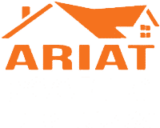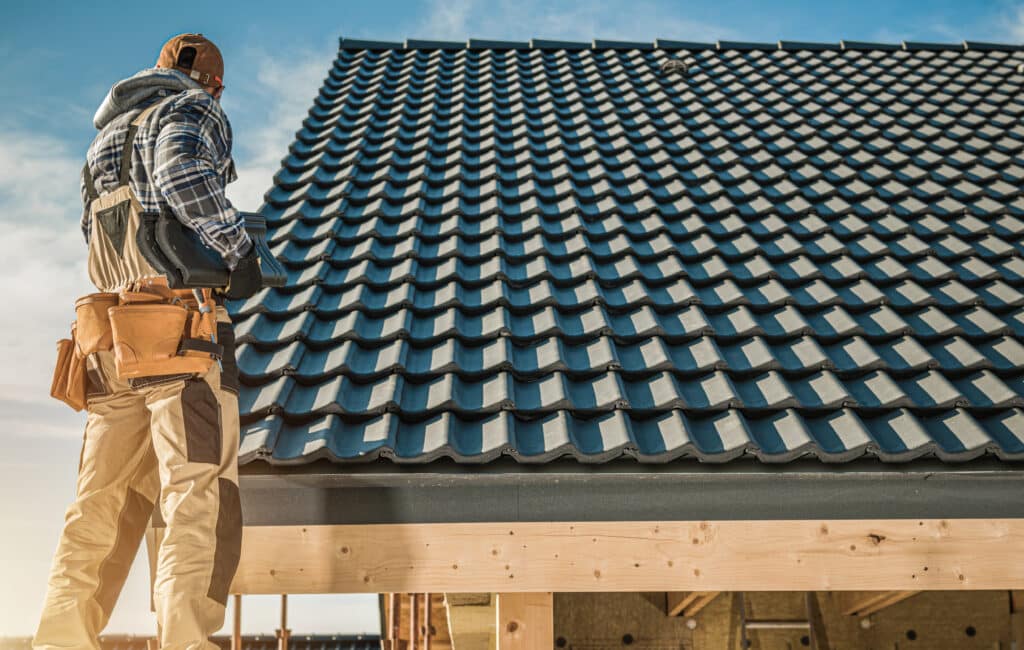Types of Tile Roofs: Pros, Cons & Style Comparisons
When it comes to residential roofing options for homes in Las Vegas, tile roofs stand out for their blend of durability, aesthetic appeal and desert climate compatibility. Roof tiles are made from long-lasting materials like clay, concrete, or slate Unlike asphalt, tile roofs—can last 50 to 100 years or more and offer superior protection against fire, UV damage and extreme heat.
Designed to be laid in overlapping rows, they provide a strong, water-shedding outer shell for pitched roofs. They’ve been used for thousands of years, particularly in Mediterranean, Spanish and European architectural styles, and are valued for both their durability and aesthetic appeal—standing the test of time and the elements.
Best Roof Tiles for Hot Climates
If you’re choosing a roof for a hot climate, clay or concrete tiles are not just desirable—they’re often the most practical long-term investment. Unlike asphalt shingles, which may degrade quickly under intense sunlight, tile roofs offer a premium look with long-term performance.
In Las Vegas, tile roofing is a popular choice not just for its longevity but also for its heat resistance, fireproof nature and ability to reflect sunlight—crucial traits in the sweltering Southwest desert climate. Tile roofs also tend to follow many local homeowners association design guidelines, blending seamlessly with the popular stucco finishes and earth-tone palettes.
Tile Roofs Outperform Other Materials in Hotter Climates:
| Advantage |
Why It Matters in Hot Climates |
| Heat deflection |
Keeps interiors cooler, reduces energy use |
| Fire resistance |
Protects against wildfires and extreme sun |
| UV durability |
Withstands long-term sun exposure |
| Ventilation |
Reduces attic heat buildup |
| Longevity |
Lowers maintenance in harsh conditions |
Clay Roof Tiles
Clay tiles are among the oldest, longest-lasting and
best roofing materials in the world. Many historic buildings in Europe and the Mediterranean still have clay tile roofs that are centuries old—a true testament to their durability and timeless elegance. Made from natural clay that is molded and kiln-fired, these tiles come in traditional barrel shapes (often called Spanish or mission tiles) as well as modern flat roof tiles for a sleeker aesthetic.
Installation Method
Clay roofs are installed by laying overlapping tiles on a waterproof underlayment, often using battens or direct fastening to the roof deck, with careful alignment and secure fastening to ensure durability, drainage and ventilation.
Clay Tile Roof Benefits:
- Exceptionally fire-resistant
- Extremely long-lasting, often 50-plus years
- Visually striking, adding timeless charm
- Ideal for the Southwest aesthetic
Clay Roof Considerations:
- Brittle and can crack under pressure (e.g., walking on the roof)
- Very heavy, possibly requiring additional structural reinforcement
- Higher cost than other tile options
Added Benefits of Clay Tile Roofing
| Benefit |
Impact |
| Energy savings |
20–30% lower cooling costs annually |
| Lifespan |
Often lasts 75–100 years or more |
| Resale value |
5–8% boost in hot, arid real estate markets |
| Insurance savings |
Discounts for fire and wind resistance (Class A rating) |
| Maintenance |
Very low, with occasional underlayment replacement every 25–30 years |
Clay vs. Concrete Roof Tiles
Clay tiles are perfect for homeowners seeking a high-end, durable roof that complements classic desert architecture while offering unparalleled lifespan and color retention. Concrete tile roofing provides a more affordable, versatile option with comparable durability. Consider not only upfront costs and maintenance needs, but also structural load capacity, as clay is significantly heavier and may require reinforced roofing support.
Concrete Roof Tiles
Concrete tiles offer a modern alternative to clay, made by combining sand, cement and water, then molding the mixture into tile shapes. These tiles can mimic the appearance of clay, slate or wood shakes, making them highly versatile. The main difference between concrete roofs vs. clay is that they are heavier, more affordable and absorb more moisture. However, they offer similar durability and heat resistance with a wider variety of styles and colors.
Concrete Roofing Tile Benefits:
- More affordable than clay
- Durable and resistant to extreme weather
- Low maintenance over the years
Concrete Roof Considerations:
- Heavier than clay, requiring professional structural assessment
- Can fade over time, especially under harsh UV exposure
- Must be professionally installed to ensure proper sealing and alignment
Concrete tiles are a strong fit for Las Vegas homeowners looking for a cost-effective but sturdy solution that still meets HOA standards and resists the region’s intense heat, making them one of the best roof tiles for hot climates.
Added Benefits of Concrete Tile Roof
| Benefit |
Impact |
| Energy savings |
15–25% lower cooling costs annually |
| Lifespan |
Often the only roof you’ll ever need |
| Resale value |
4–8% boost in hot, arid real estate markets |
| Insurance savings |
Discounts for fire/wind/hail resistance |
| Maintenance |
Minimal, aside from underlayment after 25–30 years |
A concrete tile roof is a premium upfront investment that pays for itself over time through energy savings, durability and home value retention. In hot, dry regions, it’s not just cost-effective—it’s a strategic upgrade for long-term performance.
Slate Roof Tiles
Slate tile is made from natural stone and offers a dramatic, upscale aesthetic that’s hard to match. Slate tiles are known for their dark, moody colors and natural cleft textures. Slate is typically chosen for luxury or historic homes, but it remains a viable (though rare) option in Southern Nevada for those prioritizing timeless beauty and long-term investment.
Slate Tile Roofing Benefits:
- Extremely long-lasting (up to 100 years)
- Naturally fire-resistant
- Eco-friendly, as they are fully natural and recyclable
Slate Roof Considerations:
- Heavier than concrete tile roofs, requiring reinforced roofing structures
- High cost and specialized installation
- Less common in Las Vegas due to cost and climate considerations
Added Benefits of Slate Tile Roof
| Benefit |
Impact |
| Energy savings |
20–30% lower cooling costs annually |
| Lifespan |
Can last 75–100 or more years |
| Resale value |
5–9% resale value increase in upscale or historic desert homes |
| Insurance savings |
Eligible for discounts thanks to Class A fire resistance |
| Maintenance |
Very low; underlayment replacement every 30–40 years |
Composite Roof Tiles
Composite or synthetic roof tiles are engineered from materials like recycled plastics and rubber, and they’re designed to mimic traditional roofing tiles such as slate, shake and clay. Composite tiles offer a lighter, lower-maintenance and more customizable alternative to traditional tiles, without sacrificing much in terms of looks or basic durability. Traditional tiles (especially clay and slate) have unmatched authenticity and longevity but come with higher installation costs and structural demands than synthetic tiles.
Composite Tile Roofing Benefits:
- Lightweight, reducing structural strain
- Durable and UV-resistant
- Often made from recycled materials, making them eco-friendly
- Easier and less expensive to install
Ideal for:
- Homeowners wanting a traditional tile look without the weight
- Energy-conscious consumers
- Homes in HOAs requiring a specific aesthetic but allowing alternative materials
Composite tiles are becoming increasingly popular in Las Vegas due to their versatility, energy efficiency and lower cost of ownership.
Added Benefits of Composite Roof Tile
| Benefit |
Impact |
| Energy savings |
15–25% reduction in cooling costs, depending on color and reflectivity |
| Lifespan |
Durable for 40–60 years; UV-stable options fare better in intense desert sun |
| Resale value |
3–6% increase, especially in areas with demand for eco-conscious materials |
| Insurance savings |
Discounts possible for Class A fire resistance and impact ratings |
| Maintenance |
Minimal maintenance; resistant to cracking, fading, and insect damage |
Solar Roof Tiles (Integrated Tile Roofing)
Solar roof tiles are a high-tech option that integrate photovoltaic cells directly into roofing material. Rather than mounting bulky solar panels to an existing roof—these cells are embedded into the roofing material itself. This option blends the timeless look of tile with energy-saving efficiency. Integrated PV cells—the core technology in solar roofing—converts sunlight directly into electricity, resulting in significant energy bill savings.
Solar Tile Roofing Benefits:
- Sleek, modern appearance compared to panels
- Provides energy savings over time
- Works well for eco-conscious homeowners
Solar Roof Considerations:
- High upfront cost
- Requires professional installation
- Best installed on new or fully replaced roofs
If you’re considering installing solar tile roofing, but not ready to make the initial investment, Ariat Roofing offers services to prepare traditional tile roofs for solar integration, too.
Added Benefits for Solar Tile Roof
| Benefit |
Impact |
| Energy savings |
40–70% reduction in electricity costs by directly generating solar power |
| Lifespan |
25–40 years for solar function; roof structure may last 50 plus years |
| Resale value |
4–10% boost in value, particularly in solar-friendly states |
| Insurance savings |
May qualify for discounts for Class A fire ratings and weather durability |
| Maintenance |
Low; periodic cleaning and inverter checks—modules are typically sealed, durable and weather-resistant |
Comparing Types of Tile Roofs: Which Is Right for Your Home?
Choosing the right tile roof involves weighing several factors: appearance, durability, cost, structural needs and HOA rules. Ariat Roofing is here to help homeowners evaluate all these variables to determine the best fit based on their budget, home structure and Las Vegas climate demands.
To help compare your options at a glance, here’s a final breakdown of key performance and aesthetic factors by tile roof type—covering durability, weight and cost:
Tile Roof Material Comparison
| Material |
Durability |
Weight |
Cost |
Appearance |
Ideal For |
| Clay |
50+ years |
Heavy |
$$$$ |
Classic, Mediterranean |
High-end, traditional homes |
| Concrete |
30–50 years |
Heavy |
$$$ |
Versatile (clay/slate look) |
Budget-conscious, durable choice |
| Slate |
75–100 years |
Very heavy |
$$$$$ |
Luxury, historic |
High-budget, long-term value |
| Composite |
30–50 years |
Light |
$$ |
Mimics slate/shake/clay |
Lightweight, eco-friendly |
| Solar |
25–30 years |
Varies |
$$$$$ |
High-tech, sleek |
Green-conscious homeowners |
Style, Strength and Longevity With the Right Types of Tile Roofs
In Arizona, roofing must withstand extreme sun, high heat, low humidity, monsoon rains and dust storms, especially in desert areas like Las Vegas, Phoenix and Tucson. As a result, the most common roof types are chosen for heat resistance, durability, and low maintenance.
Whether you want the elegance of a clay tile roof, the affordability of concrete tile or the cutting-edge tech of solar tiles, Ariat Roofing has extensive experience working with every type and can help you make an informed choice that matches your home’s needs, your budget and your personal style.
Contact Ariat Roofing today for a free estimate and expert guidance on the different types of roof tiles for homes. To schedule an appointment, fill out
our contact form, call
(702) 982-1382 or send us an
email for your next
tile roof installation or roof repair.

